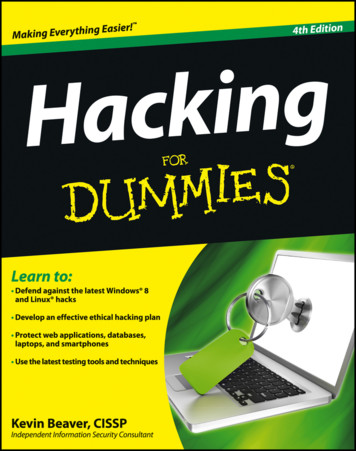Hacking WebAssembly Games With Binary Instrumentation
Hacking WebAssembly Gameswith Binary Instrumentation
WEBASSEMBLY 101
WASM101 Developers have done (and continue to do)incredible work speeding up Javascript However, the dynamic nature of Javascript willalways be a roadblock WebAssembly provides a static, pre-compiledbinary format for performance intensiveapplications
WASM101 WebAssembly "defines an instruction set andbinary format for an assembly-like architecture" WebAssembly is built to be targetable by existingcompilers and languages Finally we can write web applications in C!
WASMUSES WebAssembly video games are becoming verycommon Look at any browser game website(Newgrounds, Kongregate, etc) Unity3D and Unreal Engine 4 can now both targetWebAssembly This means there’s a lot of targets without a lot oftools
WASMUSES WebAssembly is used for a lot of types ofapplications, not just video games Retargeted desktop applications 3D applications Crypto miners .etc These techniques are not video game specific —video games are just the most fun target
WASMREVERSING With WebAssembly, web RE has started to feelmore like “traditional” binary RE Back to the disassembler! A few tools support WebAssembly (mostly staticanalysis) radare2 JEB decompiler wabt (WebAssemby Binary Toolkit)
WASMREVERSING Browser debugging capabilities for WASM arepretty lacking No watchpoints No conditional breakpoints Lots of bugs
VIDEOGAMEREVERSING Video games are a unique challenge when itcomes to RE Video game binaries are typically much larger andmore complex than other applications Video games are more performance intensive, andperformance impacts are more noticeable No one wants to play a game at 5 FPS With this in mind, I was looking for a tool likeCheat Engine for WASM
CHEATENGINE Cheat Engine (made by Dark Byte) is effectively aspecialized debugger for hacking video games Cheat Engine can: Search memory Modify and “freeze” memory Set watchpoints Inject/patch code
CHEAT ENGINE 101
We want to make our character invincible. We know our charactercurrently has 5 health
We start by searching the game’s memory for the value 5
Then we cause the value to change and search for the new value.
.and continue this process until we’ve found our health value inmemory
Now we can manipulate our health to heal ourselves
.or give ourselves more health
.or “freeze” our health so we can’t get hurt
This process can take a while and needs to be redone every time weplay. Ideally we want to permanently patch the game
We set a watchpoint on our health address, then trigger it
Now we know where health is decremented when we get hurt
.and we can patch it out
CHEATENGINEUSES Cheat Engine not only helps us hack games, it canalso be significant help in RE Using watchpoints we can associate a value inmemory to the code that affects it This is an invaluable time saver reverseengineering large applications like video games
CHEATENGINE Since WASM doesn’t have watchpoints we can’tdirectly implement Cheat Engine features Can we emulate watchpoint behavior without“real” watchpoints?
EMULATINGWATCHPOINTS First attempt: Using the browser debugger Place a breakpoint at each load/store instructionand check if the access affects our “watched”address
EMULATINGWATCHPOINTS First attempt: Using the browser debugger Place a breakpoint at each load/store instructionand check if the access affects our “watched”address Way too slow — browser becomes unusable
EMULATINGWATCHPOINTS To emulate watchpoints, we want to inject codeinto the binary at each memory load/storeinstruction Injected code will check if this access affects thememory area we are “watching” If so, trigger our breakpoint code To do all this, we need to employ some form ofbinary instrumentation
BINARYINSTRUMENTATION
BINARYINSTRUMENTATION101 In a nutshell, binary instrumentation is the processof manipulating an application binary to aid inanalysis A lot of cool binary instrumentation tools exist forother types of binaries Frida DynamoRIO .others I haven’t used There’s even some existing tools for WASM!
OTHERTOOLS Wasabi (by Daniel Lehmann) is a very coolinstrumentation and analysis tool for WASM However, it does not exactly fit our needs Wasabi is written in Rust and intended to be runfrom the terminal Wasabi does its analysis by injecting Javascript If we want to run a game at any decent FPS, weneed to call Javascript as infrequently as possible
OTHERTOOLS WABT (WebAssembly Binary Toolkit) can parseand (to some extent) modify WASM binaries It’s even been compiled to Javascript! Unfortunately, WABT’s parsing takes too long/toomuch memory for most video game binaries
OTHERTOOLS What we want is a tool that: Can instrument binaries from within thebrowser Can handle large (40MB ) WASM binariesquickly and without running out of memory
WAIL The “WebAssembly Instrumentation Library”(WAIL) is my attempt at a solution to this problem WAIL is a Javascript library focused on makingtargeted modifications to WASM binaries Can add entries to any specification-definedsection Can edit existing entries of sections Can add/remove sections
WAILPARSING WAIL uses a couple of tricks to modify binariessignificantly faster with less memory usage thanother libraries WAIL only parses sections/elements that arenecessary to perform the defined modifications WAIL parses binaries as a “stream”
STREAMPARSING The normal way of parsing a binary involvescreating a “map” of all pieces that make up thebinary Once this map is created, you modify the piecesas needed and stick everything back together This is convenient, but also slow and memoryintensive
STREAMPARSING WAIL parses binaries as a “stream” — handlingand modifying each element as soon as it is read This is more efficient because we don’t need tosave each element of the entire binary Rather, we act on a single element at a time andthen “forget” about it and move to the next
PARSINGGOTCHAS There are a few downsides to this approach: The first is that the parser can never go“backwards” Once we finish parsing a particular element, wecannot go back and make changes to it To deal with this, we must define all ourmodifications before we start parsing
PARSINGGOTCHAS In some cases, one addition to a binary will requireknowledge of another For instance, to insert a new function into aWASM binary we must: Add an element to the TYPE section Add an element to the FUNCTION section thatreferences the new TYPE element Add an element to the CODE sectioncorresponding to the new FUNCTION element
PARSINGGOTCHAS WAIL uses a special grammar to deal with thesecases Each addition we make returns a “handle” to avalue that will be resolved when parsing This handle can be used in subsequentmodifications This allows us to perform complex modificationsto binaries while still defining everything up front
The next gotcha: the function and globalvariable tables Functions and globals are referenced byindex into the respective table The function table is built by taking allimported functions, then appending allinternal functions The same goes for imported and internalglobalsIMPORTEDINDEX 0INDEX 1INDEX 2INDEX 3INDEX 4INDEX 5INDEX 6INDEX 7INDEX 8INTERNAL
INDEX 0 Therefore, if we add a new importedfunction or global, we’ve thrown off allreferences to internal functions/globalsIMPORTEDINDEX 1INDEX 2INDEX 3NEW ELEMENT(INDEX 4)INDEX 5INDEX 6INDEX 7INDEX 8INTERNAL
INDEX 0 WAIL fixes this automatically by changingaffected entries in the following sections: EXPORT ELEMENT CODE STARTIMPORTEDINDEX 1INDEX 2INDEX 3NEW ELEMENT(INDEX 4)INDEX 5INDEX 6INDEX 7INDEX 8INTERNAL
EMULATINGWATCHPOINTS First we create two new global variables One for the address we are watching One will hold two different “flags” Is watchpoint enabled? Size of value being watched
EMULATINGWATCHPOINTS Next, we add an IMPORT entry for a Javascriptfunction This function will only be called when ourwatchpoint is triggered This makes performance impact minimal
EMULATINGWATCHPOINTS Next we create a new internal function As mentioned earlier, this requires adding to theTYPE, FUNCTION, and CODE elements This new function will perform the actual logic ofour watchpoints Check if an access overlaps with our “watched”address If it does, call the “trigger” function
EMULATINGWATCHPOINTS Finally, we place calls to our watchpoint functionbefore each memory load or store instruction As long as we’re careful about performance, wecan apply watchpoints to games withoutnoticeable drop in FPS
CETUS Cetus is a browser extension that implementsfeatures of Cheat Engine for WASM Comes from the Latin word for “sea monster” Cetus intercepts and instruments WASM binarieson the fly Adds read/write watchpoints Adds “freezing” functionality Can apply user-defined patches
CETUS DEMO
MORECETUS Cetus can also do “differential” searching Used to find values when an exact startingvalue is not known Cetus also comes with a built-in speed hack Works by replacing performance.now() andDate.now()
OTHER EXAMPLES
WAIL can also be used to trace functioncalls by placing code at the beginning ofeach function This is slow, but still fairly useful
WAIL can also replace a function entirelyby swapping out all references to it For instance, we can take a WASMfunction and replace it with an importedJavascript function This way we can effectively patch WASMbinaries using Javascript
WAIL can take “internal” functions of abinary and export them This allows us to call the internal functionon command with arbitrary arguments
ADDINGSYMBOLS Using WAIL we can add our own symbols to abinary There are two ways this can be done: Add a “name” section to the binary with oursymbols Add an export entry for each function we wantto name
github.com/qwokka/wailgithub.com/qwokka/cetus
GAME HACKINGMONTAGE
specialized debugger for hacking video games Cheat Engine can: Search memory Modify and “freeze” memory Set watchpoints Inject/patch code. CHEAT ENGINE 101. We want to make our character invincible. We know our character currently has 5 health. We start by searching the game’s memory for the value 5.
Binary prices Binary prices rautmann (2013 Binary no price Epstein (2002 Binary prices al. (2014 Binary maximis- seek- er- t al. (2010 Binary individ- price al. 2014 Binary prices Binary sset prices Halevy (2019 Auction y Binary diffi- sig- nals Liang (2019 sm y Binary erreac- news al. (2012 Auction y Binary under- signals et y Gaussian erreac .
Hacking Concepts 1.10 What is Hacking? 1.11Who is a Hacker? 1.12 Hacker Classes 1.13 Hacking Phases o Reconnaissance o Scanning o Gaining Access o Maintaining Access o Clearing Tracks Ethical Hacking Concepts 1.14 What is Ethical Hacking? 1.15 Why Ethical Hacking is Necessary 1.16 Scope and Limitations of Ethical Hacking
Chapter 7 Passwords In This Chapter Identifying password vulnerabilities Examining password-hacking tools and techniques Hacking operating system passwords Hacking password-protected files Protecting your systems from password hacking P assword hacking is one of the easiest and most common ways attack-ers obtain unauthorized network, computer, or application access.
Hacking The Wild: Desert Island Castaway Survival Series Marathon Hacking The Wild: Escape from Death Valley Hacking The Wild: Deadly Glacier Hacking The Wild: Alaskan Ice Forest Hacking The Wild: Black Bayou, The Hacking The Wild: Desert Island Castaway
Chapter 7 Passwords In This Chapter Identifying password vulnerabilities Examining password-hacking tools and techniques Hacking operating system passwords Hacking password-protected files Protecting your systems from password hacking P assword hacking is one of the easiest and most common ways attack-ers obtain unauthorized network, computer, or application access.
private sectors is ethical hacking. Hacking and Ethical Hacking Ethical hacking can be conceptualized through three disciplinary perspectives: ethical, technical, and management. First, from a broad sociocultural perspective, ethical hacking can be understood on ethical terms, by the intentions of hackers. In a broad brush, ethical
Hacking Opportunities 49 Summary 49 Chapter 3 Hacking LEGO I: Connections 51 Mindstorms Wires Explained 51 Inside the Mindstorms Wire 52 Hacking Mindstorms Wires 53 Exploring Wireless Options 56 Infrared Sensor and Beacon 56 Bluetooth 57 Hacking Wireless 58 Summary 62 Chapter 4 Project: Remote-Controlled Crane 63 Parts List 64 Building the Crane 65
Signs with blue circles but no red border mostly give positive instruction. One-way traffic (note: compare circular ‘Ahead only’ sign) Ahead only Turn left ahead (right if symbol reversed) Turn left (right if symbol reversed) Keep left (right if symbol reversed) Route to be used by pedal cycles only Segregated pedal cycle and pedestrian route Minimum speed End of minimum speed Mini .























